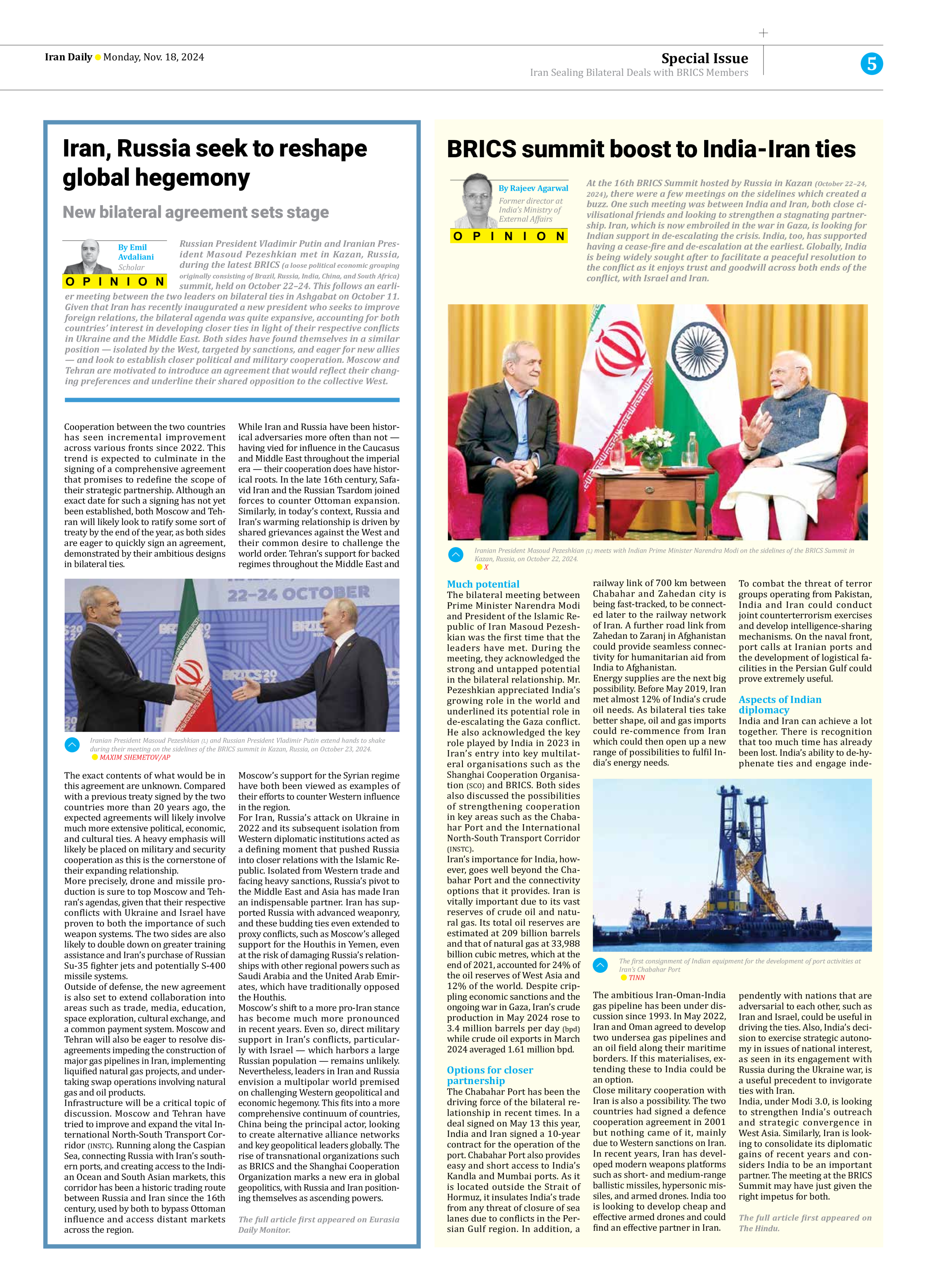
BRICS summit boost to India-Iran ties
At the 16th BRICS Summit hosted by Russia in Kazan (October 22–24, 2024), there were a few meetings on the sidelines which created a buzz. One such meeting was between India and Iran, both close civilisational friends and looking to strengthen a stagnating partnership. Iran, which is now embroiled in the war in Gaza, is looking for Indian support in de-escalating the crisis. India, too, has supported having a cease-fire and de-escalation at the earliest. Globally, India is being widely sought after to facilitate a peaceful resolution to the conflict as it enjoys trust and goodwill across both ends of the conflict, with Israel and Iran.
By Rajeev Agarwal
Former director at
India’s Ministry of
External Affairs
Much potential
The bilateral meeting between Prime Minister Narendra Modi and President of the Islamic Republic of Iran Masoud Pezeshkian was the first time that the leaders have met. During the meeting, they acknowledged the strong and untapped potential in the bilateral relationship. Mr. Pezeshkian appreciated India’s growing role in the world and underlined its potential role in de-escalating the Gaza conflict. He also acknowledged the key role played by India in 2023 in Iran’s entry into key multilateral organisations such as the Shanghai Cooperation Organisation (SCO) and BRICS. Both sides also discussed the possibilities of strengthening cooperation in key areas such as the Chabahar Port and the International North-South Transport Corridor (INSTC).
Iran’s importance for India, however, goes well beyond the Chabahar Port and the connectivity options that it provides. Iran is vitally important due to its vast reserves of crude oil and natural gas. Its total oil reserves are estimated at 209 billion barrels and that of natural gas at 33,988 billion cubic metres, which at the end of 2021, accounted for 24% of the oil reserves of West Asia and 12% of the world. Despite crippling economic sanctions and the ongoing war in Gaza, Iran’s crude production in May 2024 rose to 3.4 million barrels per day (bpd) while crude oil exports in March 2024 averaged 1.61 million bpd.
Options for closer partnership
The Chabahar Port has been the driving force of the bilateral relationship in recent times. In a deal signed on May 13 this year, India and Iran signed a 10-year contract for the operation of the port. Chabahar Port also provides easy and short access to India’s Kandla and Mumbai ports. As it is located outside the Strait of Hormuz, it insulates India’s trade from any threat of closure of sea lanes due to conflicts in the Persian Gulf region. In addition, a railway link of 700 km between Chabahar and Zahedan city is being fast-tracked, to be connected later to the railway network of Iran. A further road link from Zahedan to Zaranj in Afghanistan could provide seamless connectivity for humanitarian aid from India to Afghanistan.
Energy supplies are the next big possibility. Before May 2019, Iran met almost 12% of India’s crude oil needs. As bilateral ties take better shape, oil and gas imports could re-commence from Iran which could then open up a new range of possibilities to fulfil India’s energy needs.
The ambitious Iran-Oman-India gas pipeline has been under discussion since 1993. In May 2022, Iran and Oman agreed to develop two undersea gas pipelines and an oil field along their maritime borders. If this materialises, extending these to India could be an option.
Close military cooperation with Iran is also a possibility. The two countries had signed a defence cooperation agreement in 2001 but nothing came of it, mainly due to Western sanctions on Iran. In recent years, Iran has developed modern weapons platforms such as short- and medium-range ballistic missiles, hypersonic missiles, and armed drones. India too is looking to develop cheap and effective armed drones and could find an effective partner in Iran.
To combat the threat of terror groups operating from Pakistan, India and Iran could conduct joint counterterrorism exercises and develop intelligence-sharing mechanisms. On the naval front, port calls at Iranian ports and the development of logistical facilities in the Persian Gulf could prove extremely useful.
Aspects of Indian diplomacy
India and Iran can achieve a lot together. There is recognition that too much time has already been lost. India’s ability to de-hyphenate ties and engage independently with nations that are adversarial to each other, such as Iran and Israel, could be useful in driving the ties. Also, India’s decision to exercise strategic autonomy in issues of national interest, as seen in its engagement with Russia during the Ukraine war, is a useful precedent to invigorate ties with Iran.
India, under Modi 3.0, is looking to strengthen India’s outreach and strategic convergence in West Asia. Similarly, Iran is looking to consolidate its diplomatic gains of recent years and considers India to be an important partner. The meeting at the BRICS Summit may have just given the right impetus for both.
The full article first appeared on The Hindu.







